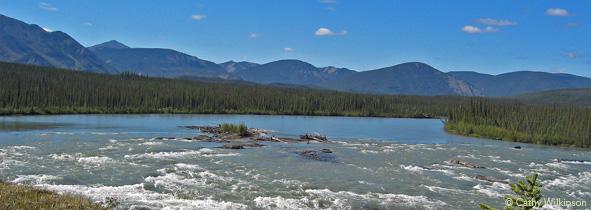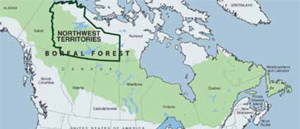Provincial and Territorial Forest Facts
Explore Canada's Boreal Forest by Province and Territory to see what makes each part of the boreal forest special.
Choose a province or territory:


Northwest Territories' Boreal Forest:
- is approximately 950,000 km2 (235 million acres) in size – more than three times the size of the United Kingdom.1
- comprises 17% of Canada's Boreal Forest.
- is home to more than 25 aboriginal communities.2
- is home to the Gyrfalcon, the Northwest Territories' official bird, and the Tamarack (Larch), the official tree.
- stores 40 billion tonnes of carbon in its soils, peat and forests – equivalent to around 200 years' worth of Canada’s GHG emissions in CO2 equivalent at 2014 levels.3
- contains the Mackenzie River Basin, which comprises 20% of Canada's landmass and is the 2nd-largest primary watershed in North America. It includes the Mackenzie River, Canada's longest river and the fifth-longest in the world, and is home to several of Canada's largest lakes including Great Slave Lake and Great Bear Lake (7th-largest in the world). The Mackenzie River supports large-scale anadromous fish migrations, including those of Arctic cisco that travel from the Mackenzie Delta at the Arctic Ocean several thousand kilometers upriver to the Liard River.4
- is the breeding ground for 150 to 500 million birds of more than 200 bird species, including White-winged Scoter, Whooping Crane, Short-billed Dowitcher, Blackpoll Warbler and Rusty Blackbird.
- supports over 6,000, or 17%, of Canada's threatened boreal Woodland caribou and 100,000 Barren ground caribou, as well as large populations of wolves, bear and other wildlife.5,6
- features 834,000 km2 (206 million acres) of intact forest, peatland and wetland habitat free from industrial development, making up 87% of the province's boreal region.7
1 Canadian Boreal Initiative. 2003. Canada's Boreal Region.
2 Aboriginal Canada Portal (www.aboriginalcanada.gc.ca) and Global Forest Watch.
3 Tarnocai, C. and Lacelle, B. 1996. Soil Organic Carbon Digital Database of Canada. Eastern Cereal and Oilseed Research Center, Research Branch, Agriculture and Agri-Food Canada, Ottawa, Canada.
4 Benke, A., and Cushing, C. Rivers of North America. 2005.
5 Environment Canada. 2008. Scientific Review for the Identification of Critical Habitat for Woodland Caribou (Rangifer tarandus caribou), Boreal Population, in Canada. August 2008.
6The CircumArtic Rangifer Monitoring & Assessment Network. Accessed August, 2009. www.carmanetwork.com
7Global Forest Watch Canada. 2009. Canada's Forest Landscape Fragments: A Second Approximation.

